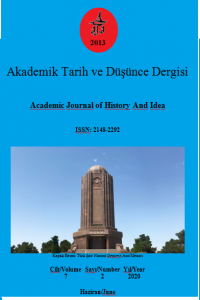Eski Doğu Toplumlarında Harem ve Hadımlık Müessesesinin Ortaya Çıkışı ve İşleyişi
Harem, Hadım, Harem Müessesesi, Hadımlık Müessesesi
The Emergence and Functioning of the Harem and Castration Institution in Ancient Eastern Societies
Harem, Eunuch, Harem Institution, Castration Institution.,
___
- AMBOS, C., “Eunuchenals Thronprätendenten und Herrscher im alten Orient”, Of GOd(s), Trees, Kings, and Scholars, Neo-Assyrianand Related Studies in Honour of Simo Parpola, (Ed. Mikko Luukko, Saana Svärd, Raija Mattila), Eisenbrauns, Helsinki 2009, s.1-7.
- ANDERSON, M. M., Hidden Power, The Palace Eunuchs of Imperial China, Prometheus Books, New York 1990.
- ASSANTE, J., “The kar.kid / ḫarimtu, Prostituteor Single Woman? A Reconsideration of the Evidence”, Ugarıt-Forschungen, C. 30, Münster 1999, s. 5-96.
- AYDIN, N., Büyük Sümerce Sözlük, Türk Dil Kurumu Yayınları, Ankara 2013.
- BODI, D., The Michal Affair, from Zimri-Limto the Rabbis, Sheffield Phoenix Press, Sheffield 2005.
- CHAMPDOR, A., Mısır’ın Ölüler Kitabı, (çev. Suat Tahsuğ), Ruh ve Madde Yayınları, İstanbul 1994.
- ÇAKAN, V., “Geçmişten Günümüze Çin”, Asya Araştırmaları Dergisi, C. 1, S. 1, Ankara 2017,s. 111-130.
- DALLEY, S., Mari and Karana: Two Old Babylonian Cities, Addison-Wesley Press, London 1984.
- DÖNMEZ, Ş., “Osmanlı Haremi’ne Assur’un Selamı Var”, Tarih Dergisi, S. 70, İstanbul 2020, s.12-13.
- DUYMUŞ-FLORIOTI, H. H., Antik Doğu’da Siyasi Evlilikler (M.Ö. III-I. Binyıl), Cinius Yayınları, İstanbul 2009.
- GELB, I. J., JAKOBSEN, T., LANDSBERGER, B., OPPENHEIM, A. L., The Assyrian Dictionary of the Oriental Institute of the University of Chicago (CAD), “Ḫ”, C. 6, The University of Chicago,Chicago 1956.
- GELB, I. J., JAKOBSEN, T., LANDSBERGER, B., OPPENHEIM, A. L.,REINER, E., The Assyrian Dictionary of the Oriental Institute of the University of Chicago (CAD), “B”, C. 2, The University of Chicago, Chicago 1998.
- GÖREZ, F., “Üçüncü Cinsiyetin Dünyası: Çinli Hadımlar”, Uluslararası Sosyal ve Eğitim Bilimleri Dergisi, C. 3, S. 6, Ankara 2016, s. 76-86.
- GRAYSON, A. K., “Eunuchs in Power Their Role in the Assyrian Bureaucracy”, Alter Orient und Altes Testament Veroffentlichungenzur Kultur und Geschichtedes Alten Orientsunddes Alten Testaments, (Ed.Manfried Dietrich-OswaldLoretz), Neukirchener Verlag Neukirchen, Toronto 1995,s. 85-98.
- HALAÇOĞLU, Y., X1V-XVII. Yüzyıllarda Osmanlılarda Devlet Teşkilâtı ve Sosyal Yapı, TTK Yayınevi, Ankara 1991.
- HARMAN, Ö. F., “Aziz-i Mısr”, Türkiye Diyanet Vakfı İslam Ansiklopedisi, C. 10, TDV Yayınları, İstanbul 1991, s. 343-344.
- HAWKINS, J. D., “Eunuchs among the Hittites”, Sex and Gender in the Ancient Near East: Proceedings of the 47th Rencontre Assyriologique Internationale, Helsinki, July 2–6, 2001, (Ed. S.Parpola, R. M. Whiting), Helsinki 2002, s. 217-233.
- HEIMPEL, W., Letters to the King of Mari, Eisenbrauns, Indiana 2003.
- HERODOTOS, Tarih, (çev.Müntekim Ökmen), Türkiye İş Bankası Yayınları, İstanbul 2016.
- KERTAI, D., The Architecture of Late Assyrian Royal Palaces, University of Oxford Press, United Kingdom 2015.
- KILIÇ, S. Ö., “Hadımların Pers Saray Yaşamındaki Yeri”, Celal Bayar Üniversitesi Sosyal Bilimler Dergisi, S. 18 (Özel Sayısı), Manisa 2020,s. 404-416.
- MARSMAN, H. J., Women in UgaritandIsrael, Their Social and Religious Position in the Context of the Ancient Near East, Brill, Leiden 2003.
- MICHALOWSKI, P., The Lamentation over the Destruction of Sumerand Ur, Eisenbrauns, Winona Lake 1989.
- MIEROOP,M. V. de, “Women in the Economy of Sumer”, Women's Earliest Records From Ancient Egyp tand Western Asia, (Ed. Barbara S. Lesko), Scholars Press, Atlanta 1989, s. 53-66.
- ROTH, M. T., Law Collections from Mesopotamia and Asia Minor (Writings from the Ancient World), Society of Biblical Literature, Atlanta 1997.
- SHARLACH, T. M., An Ox of One’s Own Royal Wives and Religion at the Court of the Third Dynasty of Ur, Studies in Ancient Near Eastern Records (SANER), C.18,De Gruyter, Berlin 2017.
- SOLVANG, E.K., A Woman’s Palace is in the House: Royal Women of Judah and their Involvement in the House of David, Sheffield Academic Press, London 2003.
- STOL, M., Women in the Ancient Near East, (çev.Helen-Mervyn Richardson),Walter de Gruyter, Berlin 2016.
- TADMOR, H., “Rab-sarisand Rab-shakeh in 2 Kings 18”, The Word of the Lord Shall Go Forth: Essays in Honor of David Noel Freedman in Celebration of his Sixtieth Birthday, (Ed. Carol L. Meyers, M.O’Connor, Eisenbrauns, Winona Lake Indiana 1983, s. 279- 285. TOKALAK, İ., Bizans-Osmanlı Sentezi, Bizans Kültür ve Kurumlarının Osmanlı Üzerindeki Etkisi, Gülerboy Yayıncılık, İstanbul 2010.
- TURÇANİNOV, G. F., Kafkasya’da Bulunan Antik Eserlerin Keşfi ve Yazılarının Çözümlenmesi, (çev. Kayhan Yükseler), Kafdav Yayıncılık, Ankara 2009.
- ULUÇAY, Ç., Harem II, TTK Yayınları, Ankara 1992.
- ULUTÜRK, M., “Osmanlı’da Harem Meselesi”, Tefekkür Dergisi, S. 44, Konya 2011, s.1-5.
- UZUNÇARŞILI, İ. H., Osmanlı Devleti’nin Saray Teşkilatı, Türk Tarih Kurumu Yayınları, Ankara 2014.
- WILKINSON, T., The Rise and Fall o Ancient Egypt, Random House, New York 2010.
- WRIGHT, J. L., “Kingand Eunuch: Isaiah 56:1–8 in Light of Honorific Royal Burial Practices”, JBL, C. 131, No: 1, Atalanta 2012, s. 99–119.
- ZIMMERN, H., “Über Bäcker und Mundschenk im Altsemitischen”, ZDMG 53, Stuttgart 1899, s. 115-119.
- Yayın Aralığı: Yılda 6 Sayı
- Başlangıç: 2013
- Yayıncı: Hakan YILMAZ
Yeni Uygur Türkçesinin Dil Özellikleri ve Azerbaycan Türkçesiyle Ortaklıklar
44 Günlük Vətən Müharibəsi Ərzində və Sonrasında Azərbaycan-Avropa İttifaqı Münasibətləri
Necîb Mahfûz’un Roman Türünün Gelişimindeki Rolü
Rashad SEYİDOV, İbrahim YILMAZ
Signs of Civil Society in Kazakhstan
Makpal JEKEBAYEVA, Merey MURATOVA, Meiramkul ISSAYEVA
Ulusal Musikinin Öncü Cemiyeti: Ses ve Tel Birliği (1940-1972)
Eski Anadolu’da Türkler ve Türkler’in Anayurdu Sorunu
Türk Dili Poetikası ve Türk Dili Felsefesi Araştırmaları Üzerine
Prerequisites for the Development of the Rule of Law in Kazakhstan
